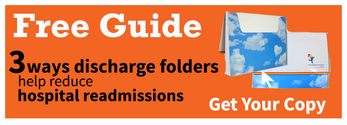 One of the most common questions floating around the healthcare community today is "how can we create a better discharge process?"
One of the most common questions floating around the healthcare community today is "how can we create a better discharge process?"
Recent government studies have revealed numerous patient problems and huge costs associated with unplanned admissions after discharge. Collectively these issues are costing hospitals tens of billions per year, and adversely impacting patient outcomes. Accordingly, the government is placing far more emphasis on discharge procedures and patient post-care.
With Medicare penalties for poor performance and 30 day re-admissions going up again, many hospitals are forced to improve in these areas or face massive cost increases. The thing is, it can't be a band-aid fix. Repeated studies have shown that a full overhaul of the discharge process is v
irtually always needed.
And a simple, low-cost patient discharge folder can become the centerpiece of the entire process.
Five Ways Discharge Folders Promote Better Patient Education
I. Creating A Patient-Focused Process
Hospitals have long been focused on their own internal processes, and have expected the patients to simply comply. While this is often necessary during day-to-day operations, the patient has to come first when it comes to educating them on their condition and their ongoing care.
Beginning a patient's discharge folder on day one, and populating it with information throughout their stay, ensures that the patient stays up to date with their ongoing care in the hospital, while building a resource for their aftercare.
II. Continually Reminding Staff Of The Process
When the patient's folder is kept near or alongside their chart, it prevents staff from overlooking the importance of good patient education. Whenever more documentation needs to go inside, it's also another opportunity for the nurse or attending physician to verify the contents are accurate.
Over the course of days or weeks, so many eyes will be on that discharge folder that it becomes very difficult for wrong information to slip in. Likewise, there should always a process in place for staff to report any potential errors they spot in the patient folder.
III. Allowing Complete Review Of Patient Documents Prior To Release
A lot of hospitals tend to leave patient education off until near the end of their stay, or even until discharge itself. Unfortunately, such a process virtually guarantees the patient won't be able to absorb/remember the information they're told.
Instead, with a patient-focused process based around the discharge folder, discharge becomes the opportunity to verify and reinforce all the information the patient has already been told. A final run through the materials in the folder allows staff to verify one last time the patient has everything they need for a successful recovery.
IV. Providing A Custom Guidebook For The Patient
The most crucial period for patient recovery is often after they've left the hospital, when it's up to them to complete their recuperation without direct oversight. When they've been receiving materials consistently throughout the process, they'll be familiar with their discharge folder from the beginning.
It gives them an all-in-one reference for anything they might need to know about their condition, along with full lists of instructions on everything from diet to personal activity.
This can often be especially useful for patients facing a long road map to recovery. In such cases, the patient folder can be arranged chronologically, with separate sections broken up by recovery milestones over the months to come.
On top of everything else, this helps give the patient a sense that their recovery is proceeding, as they slowly work through the folder.
V. Compiling Easy Reference Materials For Other Caregivers
One aspect of recovery that's often overlooked entirely is the role played by family members or other caregivers who'll be watching over the patient at home. Their friends and family will want to know about their condition, and anything they might need to know in case of emergency.
Likewise, even experienced at-home nurses could benefit greatly from having a well-organized reference guide to the needs of their charge.
So a well-organized and verified discharge folder provides yet another safety net in the days following a patient's release. It helps ensure that everyone involved in the patient's recovery has complete information in an easy-to-access fashion. That alone can prevent a lot of needless problems.
Inexpensive Discharge Folders Prevent Very Expensive Fees
The costs associated with each unplanned readmission can easily reach $40,000 or more, yet can be averted in part thanks to a folder that only costs a few dollars per patient. By putting a patient discharge folder at the center of your patient education, you can make positive changes in the way your hospital handles post-release care.
Get our free guide to Discharge Folders
And if you'r eready to try our folders out for yourself...



